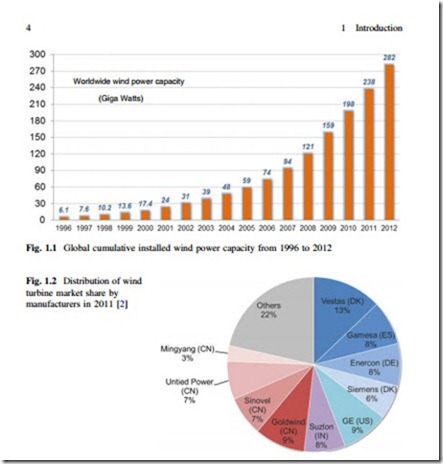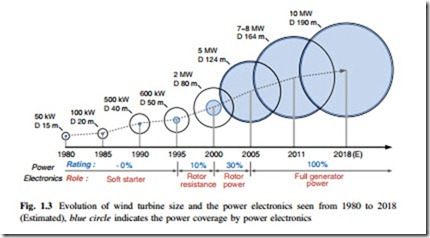State-of-the-Art for Wind Power Generation
Wind Turbine System (WTS) is still the most promising renewable energy technology. It started in the 1980s with a few tens of kW power production per unit, while nowadays multi-MW wind turbines are being installed. There is a wide-spread use of wind turbines in the distribution networks and more and more wind farms start to be connected with the transmission networks [1].
The cumulative wind power capacity from 1996 to 2012 is shown in Fig. 1.1; it can be seen that the wind power has grown fast to a capacity of 282 GW with around 45 GW installed only in 2012—this is more than any other renewable energy sources [2]. In 2011, the global electric power installation was around 208 GW; this number indicates that the wind power is really an important player in the modern energy supply system. As an extreme example, Denmark has a high penetration by wind power, and today more than 30 % of the electric power consumption is covered by wind. This country even has the ambition to achieve 100 % non-fossil-based power supply by 2050 [3].
Regarding to the markets and manufacturers of wind power, China has the largest market with over 17.6 GW capacity installed in 2011, together with the EU (9.6 GW) and USA (6.8 GW) sharing around 85 % of the global market. The Danish company Vestas was still on the top position among the largest manufacturers, closely followed by the GE and Goldwind. Figure 1.2 summarizes the worldwide top suppliers of wind turbines in 2011. It is interesting to see that there are four Chinese companies in the Top 10 manufacturers with total market share of 26 % [2].
Besides the quick growth in the total installed capacity, the size of individual wind turbine is also increasing dramatically in order to reduce the price per gen- erated kWh. In 2011, the average turbine size delivered to the market is 1.7 MW, among which the average offshore turbine size achieves 3.6 MW. The growing trends of emerging turbine size between 1980 and 2018 are shown in Fig. 1.3; it is noted that the cutting-edge 8 MW wind turbines with diameter of 164 m have already shown up in 2012 [4]. Right now most manufacturers are developing products in the range of 4.5–8 MW, and it is expected that more and more large wind turbines with multi-MW power level, even up to 10 MW, will be present in the next decade—driven mainly by the considerations to lower down the cost of energy [5].

